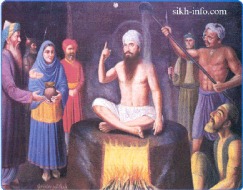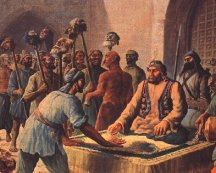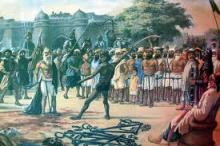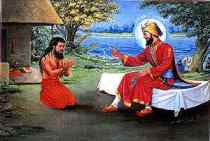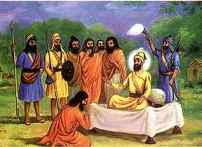Guru Gobind Singh travelled to Nanded accompanied by Mughal Emperor Bahadur Shah in 1707-1708. For my readers to understand as to why they came to be together when the Mughal rulers were otherwise fighting against the Gurus and their followers, it’s necessary to briefly know the background leading to this event.
And before I go further, let me clarify that readers should not confuse the name of Bahadur Shah with the last Mughal Emperor Bahadur Shah Jafar. Their rule was almost 150 years apart and the later was deposed by the British in 1857 after the battle of Delhi and banished to die a lonely and ignoble death in Rangoon, Burma (Myanmar).
The popularity of Guru Arjan Dev, the 5th Guru of the Sikhs, caused much concern to the Mullahs and in particular to Shaikh Ahmad Sirhindi (1569–1624), leader of the Naqashbandi School of thought which countered the liberal policies of Emperor Akbar’s reign, the 3rd ruler of the Mughal dynasty. They all prodded Emperor Jahangir, the 4th ruler, for strong action against Guru Arjan Dev. Jahangir wrote in his autobiography titled ‘Jahangirnama’, “The Hindus going to this Guru is understandable but even the stupid Muslims are going to him. I think I will ask him to either change his ways or accept Islam.”
Guru Arjan Dev was arrested in June 1606 on flimsy charges and as an alternative to being let-off, conversion to Islam was offered. But he stood his ground and was tortured in Lahore, now in Pakistan. When extreme torture did not break him, it was decided to wrap him up in a freshly skinned cowhide and throw him out in the hot June sun: The fresh hide would shrink and squeeze him into submission. Guru Arjan Dev asked for a last wish to be fulfilled, before certain death: He wanted to wash off his bloodied body so that the hide of the holy-cow would not be defiled. His tormentors found it very amusing and permitted him to enter Ravi River for a bath which runs west of the city. He went into ‘Jal Samadhi’ (Deep Meditation in Water) and never came out. Gurdwara Dehra Sahib, Lahore stands on the site of his martyrdom.

Guru Arjan Dev was made to sit upon a hot-plate while he was offered conversion on Islam for being let-off
By torturing a divine personality of Guru Arjan Dev’s eminence, Jahangir had unwittingly started digging the grave of the Mughal Dynasty. His action contrasts his ancestors Babar, Humayun and Akbar who paid due respects to all the previous four Gurus: Guru Nanak the 1st, Guru Angad the 2nd, Guru Amar Das the 3rd and Guru Ram Das, the 4th.
The attitude of Shahjahan was no better but Aurangzeb’s maltreatment of non-Muslims went beyond all reasonable limits. He unleashed a reign of terror upon the Hindus by forcibly converting them by the sword besides strongly opposing to the Sikh Gurus.
Most readers may not know that the Koran justifies the use of sword if other coercive ways don’t make ‘non-believers’ accept Allah as the only God even though such ‘non-believers’ maybe very devout in their own ways and believe in one formless God. And Aurangzeb’s effort to spread Islam in India was highly appreciated by the Caliph of Islam who lived in Baghdad, Iraq.
According to the ‘History of Kashmir’ by P. N. K. Bamzai, when Aurangzeb’s atrocities became unbearable, the Brahmins of Kashmir went to the holy Amarnath cave in the higher snowbound ranges of Himalaya to pray to Lord Shiva. At night, as they slept, one of them saw Lord Shiva in his dream telling him. “No one can save Hindu religion now except Guru Teg Bahadur, the 9th Guru of the Sikhs at Anandpur Sahib in Punjab.”
Guru Teg Bahadur had earlier founded Anandpur Sahib and it was his place of residence. According to Bamzai a group of 500 Kashmiri Brahmins came to him on 25th May 1675 led by Kirpa Ram Dutt, a Sarasvat Brahman of Matan, near Srinagar (he later became Kirpa Singh).
According to another writing, titled ‘Bhatt Vahi Talaunda’ the number was sixteen (16): But both accounts verify the authenticity of the fact that the Kashmiri Brahmins came to Guru Sahib
After listening to their predicament, Guru Teg Bahadur was deeply concerned. Just then Gobind Rai, the 9 year old son of the Guru who later became Gobind Singh, walked into the room where he saw everyone in a pensive mood. When he asked his father the reason for their predicament, he told him everything. Normally a question by a 9 years old child on a serious matter would be dismissed with some excuse but his father seemed to know the real spiritual caliber of his son. When Gobind Rai asked, “What is the remedy for it, dear father?” his father said, “It demands sacrifice by a personality of high eminence.” Gobind Rai said, without batting an eyelid, “There is no other soul of eminence in the whole country other than you, dear father.”
It was indeed remarkable that a minor son asked his father to sacrifice himself at the altar of justice and righteousness and that too for the sake of people who worshiped statues of gods and goddesses. The Sikh philosophy, enunciated from the time of Guru Nanak, opposes the worship of statues and emphasizes the worship of one formless God Almighty by reciting ‘His Name’. It’s also very significant to note that there were -and they still exist to this day- four Shankaracharyas (akin to Cardinals of Christianity) –all Brahmins who are supposed to be guardians of Hindu religion.
The first one is located at Jyotirmath in Uttarakhand in North India -about 300 kms east of Anandpur Sahib where Guru Teg Bahadur lived. The other three are at Puri in Odisa in the East, Shringeri at Karnataka in the South and Dwarka at Gujarat the West –thus covering the whole of India. They were established in the 9th century and were supposed to be and still are the spiritual heads of Hinduism.
Unfortunately they never ever made any effort to stop forcible conversions and demolition of temples by Muslims -ever since Islam came to India. Instead, in total antipathy, they jealously guarded the areas under their own Matthas (Monasteries). They lived in a selfish manner and were not even on talking terms with each other. Had they been selfless with some foresight, they could have called upon the numerous Rajput rulers -whom they the Brahmins had elevated to the number two position in the Caste system as guardians of the society- to stand united against the onslaught of Islamic rulers.
But the selfish Rajput rulers were themselves constantly at war with each other besides vying to send their daughters to the Mughal harams. And the countryside was pillage by unscrupulous marauders who took away not only the wealth of India but thousands of men, women and children as slaves to be sold-off as far away as Europe –the Gypsies of Europe say, “We came from Bharat Maa”. And when many of the Indian slaves died crossing the snowy mountains between India and Afghanistan, the Islamic plunderers mockingly named them ‘The Hindu Kush’ meaning ‘The death trap of Hindus’.
And the most remarkable part of this history is that when Lord Shiva appeared in the dream of one of the Kashmiri Brahmins, ‘He’ did not tell them to go one of the four Shankaracharyas. Why? Because Mahadev (literally meaning ‘the highest among the gods’ as Lord Shiva is also called) knew all along that the so called custodians of Hinduism were actually a bunch of selfish and slimy individuals who were more concerned about feeding their fat bellies with goodies from the poor and upping their massive egos than doing any good for the society.
Gobind Rai was indeed right when he said to his father, “There is no other soul of eminence in the whole country other than you, dear father.”
Google ‘Shankaracharyas’ for more details.
After hearing the fearless verdict from his minor son, Guru Sahib asked the Brahmins to send a word to Aurangzeb that ‘if Guru Teg Bahadur accepts Islam they shall willingly convert’. Thereupon, Kirpa Ram Dutt and his companions sent a petition to Emperor Aurungzeb through the Governor of Lahore. The Brahmins of Hardwar and Banaras –two other major centers of pilgrimage in north India- also conveyed the same message when they heard about the Guru’s decision. They were all very sure that Guru Teg Bahadur would stand his ground like Guru Arjan Dev had done in the past. Why didn’t the Brahmins of Hardwar and Banaras go to one of the nearest Shankaracharyas?
The Sikh Gurus, by personal example, had shown to their Sikhs ‘how one has to offer martyrdom at the altar of justice’ -fearlessly.
Guru Teg Bahadur installed Gobind Rai, his 9 year old son, as the 10th Guru and prepared to leave for Delhi to face his remarkable destiny. He had literally challenged the Mughal Emperor and a challenge or a dare to his authority was like asking for death. As soon he came out of the jurisdiction of Anandpur Sahib, he was arrested, shackled with heavy chains like an ordinary criminal, put into a cage and carried on top of an elephant all the way to Delhi as the Muslim masses on the way hackled and taunted him for daring the Emperor. In shackles he was marched in front of Aurangzeb in the Diwan-e-Aam (the general court) inside the Red Fort and the Emperor gave him a choice: ‘accept Islam or be executed’. Guru Teg Bahadur preferred martyrdom to conversion. By living up to the expectations of the Brahmins, of which they were very sure, he saved Hindu religion from permanent extinction forever.
Unfortunately the present day Hindus shamelessly prefer to overlook this fact. Book Publishers of Hindu background are so ungrateful that they prefer to print books about several gods and goddesses and never mention Guru Teg Bahadur’s martyrdom and sacrifice. They don’t print books about him because it would remind them of this shame.
With the martyrdom of Guru Teg Bahadur the grave of the Mughal Dynasty –which Jahangir had started digging- was complete. Now it was a matter of time before the final demise of their rule. Since the Gurus had shown to their Sikhs ‘how they had to feed the insatiable appetite of the cruel demon of religious persecution’, the Sikhs made innumerable sacrifices for the overall good of the country in the face of systematic persecution that followed by the Mughal tyrants.
Guru Teg Bahadur was beheaded in full public view on 11th November 1675 at the Kotwali (police station and prison) where Gurdwara Sheesh Gunj now stands in Chandni Chowk bazaar, Delhi. The martyrdom of his father motivated Guru Gobind Rai, the 10th Guru of the Sikhs, to prepare for a big event. Since he was only 9 years old he marked time to prepare himself for the future. When he came of age, he created the ‘Khalsa Panth’, the Brotherhood of the Pure in March 1699 to defend the meek and hapless. That is the time when from Guru Gobind Rai he became Guru Gobind Singh by suffixing the ‘Singh’ (Lion) to his name, like he had made his followers do.
The creation of ‘Khalsa Panth’ brought the Guru in direct confrontation with the Mughals who were unfortunately helped by the 22 Hindu hill Rajas of present day Himachal Pradesh and Uttarakhand. The Guru’s force being small and inexperienced was pitted against larger numbers but the Sikhs gave no-quarters and asked for no-concessions: Each Sikh killing many before falling in battle. The Mughal Commanders in the field along with their hill associates swore upon the Koran and the holy-cow, respectively, promising Guru Gobind Singh a safe-passage if he left the fort and went away elsewhere. Guru Sahib knew that the promise was false but his inexperienced fighters urged him to agree: Shortage of urgent supplies forced the situation. (Blockade of forts was the most effective tactic in those days to force terms and conditions upon opponents -like imposing sanctions upon defaulting countries now.) When Guru Gobind Singh came out of the fort on a cold and rainy December 1705 night, the immoral and deceitful enemy attached him, backing off from their solemn promise.
This was the ultimate sin which further accelerated the downslide of the Mughals.
Guru Gobind Singh lost two of his four sons in the battle. The other two along with their grandmother were entrusted for safe passage to his cook Gangu Ram, a Kashmiri Brahmin of Kaul Gotra. But, instead of following the age old Hindu norm, ‘A guest is to be treated like God’ he turned them over to the Governor of Sarhind for a prize. They were bricked up alive for refusing to accept Islam and their grandmother died of shock seeing the cruelty meted out to children who were just 7 and 9 years old.
It maybe coincidental but Indira Gandhi was also of Kaul Gorta and some people believe that she was, perhaps, Gangu’s descendant. The fact is that Jawaharlal Nehru, Indira Gandhi’s father, mentions in his autobiography that Raj Kaul, Gangu’s son was allotted a Jagir (perpetual land-lease) by Mughal Emperor Farrukhsiar near a canal west of Delhi about the year 1716. The family name ‘Nehru’, according to him, originated because of the residence being next to a canal meaning a Nehar in Persian.
We are now seeing the Taliban perpetuate the same cruelty upon innocent people. Is that the writing on the wall? Is history going to repeat? It would be worthwhile waiting for the demise of ‘a cruel culture’.
Once the news about the martyrdom of his sons reached Guru Gobind Singh, he wrote a severe indictment called ‘Jafarnama’ (moral victory) to Aurangzeb -a masterpiece in Persian language- exposing his double standards and immoral rule. When Aurangzeb read it, he regretted but it was too late. The Emperor fell ill shortly thereafter and died on 20 February 1707.
When Bahadur Shah became the Emperor after Aurangzeb, his actual name was Qutb ud-Din Muhammad Mu’azzam and he was the Governor of Kabul. His younger step-brother, Azam Shah –the other son of Aurangzeb- was the Governor of the southeastern part of the empire as shown in the map below. Azam Shah declared himself the next Emperor and ascended a make-believe throne at Ahmadnagar though the capital was Delhi. The map also indicates the general geographical location of the Sikhs, Rajputs and Marathas who carved their respective Empires after the Mughals -for a short period though- before the English took over the whole of India.
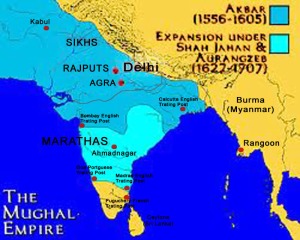
Extent of Mughal Empire when Bahadur Shah asked for military help from Guru Gobind Singh. Then the downfall came
Fighting for the throne and killing your kith-and-kin was the ultimate sin which caused the downfall of the Mughal dynasty. Discredit for this trend falls squarely upon the shoulders of Aurangzeb who got rid of his elder brother Dara Shikho though their father Shahjahan had nominated him as the successor. Aurangzeb literally walked over the blood of all his brothers to ascend the throne besides pre-maturely imprisoning his father for the rest of his life in Agra fort. Then to appease the diehard Sunni Mullahs –who didn’t approve of his deeds and perhaps to condone for his sins- Aurangzeb began to rule by the Sharia (Islamic Law) which caused the abovementioned events to take place.
Once the war of succession became imminent, Muazam sent a request to Guru Gobind Singh for military help. Guru Sahib was by then camping at Sirsa and the request for military help was unusual. A change of attitude was, perhaps, necessitated after the Mughal Commanders observed the fighting tenacity of the Guru’s followers. Though Muazam was not directly involved in such campaigns -being far away in Kabul- but reports reaching him may have shown the writing on the wall: The possibility of a Sikh military force emerging in north India.
Guru Gobind Singh agreed to give military support on two conditions: Firstly when Muazam becomes the Emperor he would treat all his non-Muslim subjects as equals and Secondly he would hand over to the Guru all those who committed atrocities upon his Sikhs. Though it may seem that the defaulters were to be ‘punished’, on the contrary, no Guru had ‘ever-punished-anyone’. In fact, during the short history of Sikhism, their sermons had made human beings out of demons.
After Muazam agreed to the two conditions, a Jatha (Group or Troop) of Sikhs blessed by Guru Gobind Singh was sent. He did not take part in the battle since he wanted his followers to stand alone and develop their military skills for the future. Moreover, he had pronounced, when he created the ‘Khalsa Panth’ in 1699, that he as their Guru, would always be present among his Sikhs whenever they would remember him. Therefore Guru Gobind Singh was with them all the time in the battle.
The crucial battle was fought at a place called Jajuwan -north of Agra- on 19 June 1707 and Muazam was victorious. To permanently remove any challengers to the throne, Muazam executed his younger step-brother Azam Shah and his two sons. He thereby added some more misdeeds to the cauldron of sins setup by his father, grandfather and great-grandfather.
After Muazam became the Emperor, Guru Gobind Singh went from Sirsa and to Moti Bagh in Delhi where a Gurdwara stands on the Ring Road now. Then, on invitation from Bahadur Shah, he went to Agra. The Mughal Emperor received him very courteously in the Durbar getting up from his throne to do so and offered a seat which was never done: Others had to remain standing. Then he presented Guru Gobind Singh with a Khilat -a trail of expensive gifts. The Khilat also included a Saif (equivalent of the Indian Khanda or the European Broad Sword) shown below which once belonged to Hazrat Ali, the son-in-law of Prophet Mohammad. The Saif was sent to Aurangzeb by the Caliph of Baghdad in appreciation of his efforts to spread Islam in India. It’s now preserved among the weapons of Guru Gobind Singh at Keshgarh Sahib Gurdwara in Punjab, India.

Guru Gobind Singh rode into the Durbar and Bahadur Shah got up from his throne to receive him which was not normal for Mughal Emperors to do so

1. Nasr min Allah wa fatah qareeb Translation: Help and victory from God is near.
2. La illahha illallah Muhammad ur Rasullallah (First kalma Tayyaba ) Translation: There is absolutely no deity worthy of worship except Allah, and Mohamed (saws) is the Messenger of Allah.
3. Mohitee Ilim Rakund Mohar Amirul Mominin Heder Ama-al-jinn Wal-ins so wasral Mustafa haque. Translation: The seal of Amir ul Momineen Haider encompasses The Knowledge. Of the jinns and of humans, The Legatee of the Chosen One, indeed.
4. Bismillah hir rahman ir rahim Translation: In the name of God, most Gracious, most Compassionate” Thufa Ast : Ali Fatima Hasan & Hussain
5. La fatah illa Ali La saif illa Zulfiqar. Translation: There is no hero except Ali; there is no sword except his sword Zulfikar
The photograph of his weapons shown above is placed opposite page number 101 of ‘Mahan Kosh’ (Encyclopaedia of Sikh Literature) compiled by Bhai Kahan Singh Nabha. Names of the weapons from front left to right are: Barsha (long blade spear), Jeejail (front loading musket), Khanda, the Saif mentioned above, Kataar (a close combat dagger) and Nagni (a twisted-steel-shaft long spear). Page number 101 also has an impression of five inscriptions in Arabic and Persian scripts carved into the steel blade of the Saif as displayed below along with their translations. I acknowledge with thanks the translations done by Arabic and Persian scholars known to Syed Ehtesham Rizvi, the Librarian, Center for Art and Archaeology, American Institute of Indian Studies, Gurgaon, India.
After presentation of the Khilat, Guru Gobind Singh reminded the Emperor of the two conditions he had agreed upon but Bahadur Shah remained noncommittal. Maybe, he didn’t want to antagonize many anti-Sikh elements his Court. However, instead of chastising the Emperor, Guru Sahib decided to persuade him. The Emperor requested Guru Sahib to accompany him towards the Deccan, the southern peninsula of India, where the Mughals were fighting the Marathas in the present day hinterland of Bombay. During their ride together Guru Gobind Singh reminded him about his promises on several occasions but Bahadur Shah evaded the subject.
Some anti-Sikh elements in the army tried to provoke a fight with the trusting Sikhs and a prominent Sikh named Maan Singh was killed by them. Despite the provocation, the two reached Nanded where Guru Sahib tried for the last time to persuade the Emperor. When he found him backtracking on his word, Guru Gobind Singh told the Emperor on his face that he would rule for a very short period.
By not keeping his word, the Emperor dumped some more sins into his account which started the process of putting the Mughal Dynasty into its grave.
The words of Guru Gobind Singh came true and Bahadur Shah ruled from 1707 to 1712 –for 5 years only- and was mercilessly killed in Lahore by his own sons at the age of 70. The rulers after Bahadur Shah –in particular Farrukhsiar- laid a prize on the head of a Sikh: Anyone bringing the chopped head of a Sikh got 10 Rupees as shown in art impression below. All such historic orders were recorded in the Court Diary of the Mughals called ‘Darbarey Akhbaar Maula’.
The Mughal Dynasty’s cauldron of misdeeds continued to simmer with many more sins committed by those who followed. Unheard of things happened to succeeding rulers until the last one in 1857.
Guru Gobind Singh probably knew all along that Emperor Bahadur Shah would not keep his word. His willingness to let his Sikhs fight for the Mughals was meant to train them for bigger military confrontations which subsequently enabled them to play bigger roles in the history of north India.
It may sound coincidental but the fighter to continue the struggle against the Mughals was found by Guru Gobind Singh in Nanded itself a short distance away from the spot where he had his last meeting with Bahadur Shah. The name of the fighter was Madho Dass, a Bairagi Sadhu, meaning ‘the one who had renounced the worldly life of a householder’. He was given the Pahul in September 1708: baptized with Amrit prepared with the Khanda in the same way as Guru Sahib had done for the first time in March 1699. Thus he became a Sikh of Guru Gobind Singh and was named Gurbaksh Singh, meaning ‘blessed by the Guru’.
However he came to be known as Banda Bahadur or Banda Singh Bahadur. This happened when he met Guru Gobind Singh for the first time sitting on his Asan or his seat in a comfortable pose. He asked in a challenging voice, “Who are you?” Guru Sahib asked, “Don’t you know who I am?” Madho Das realized who he was and said, “Oh, so you are Guru Gobind Singh.” Then, with due humility, he lowered his head to the ground and said, “Guru Maharaj, I am your Banda,” meaning ‘Male Slave’. Thus he was known as ‘Banda of the Guru’ and when he crushed Mughal rule in Punjab, his followers called him Banda Bahadur or Banda Singh Bahadur. For full details about Banda Bahadur click http://www.sikh-heritage.co.uk/warriors/Banda%20Bahadur/Banda%20Bhadur.htm
Art impressions below depict the event as it happened.
By finding Madho Das at Nanded and by channelizing the supernatural powers of a Bairagi Sadhu, Guru Gobind Singh set an example for us: ‘For performing insurmountable deeds you have to develop your spiritual self through prayer and devotion to God Almighty’.
Gurbaksh Singh alias Banda Bahadur alias Banda Singh Bahadur shook the foundation of Mughal Empire in North India during the next seven years -1709 to 1715- and paved the way for complete liberation of Punjab from 1764 onwards. His pioneering struggle helped establish the Sikh Empire which put a stop to the six monthly raids from Afghanistan and forcible conversion of people. It was achieved at great personal sacrifices by innumerable Sikhs of Guru Gobind Singh.
Yet when the Sikhs came to power under Maharaja Ranjit Singh and other princely rulers south of Sutlej River, they did not go about putting Muslims to the sword in the same way as it had been done to them.
Had it not been for the events that took place –sacrifices of the Gurus and their selfless Sikhs- there would not have been Pakistan, today.
There would have been just one country called ‘The Islamic Republic of Hindustan’ with Hinduism banished to the corridors of museums.
Women wearing Burqa would have gawking in wonder at the Hindu artifacts and beautifully carved statues of gods and goddesses. A socialite among them may have commented placing her manicured palm upon her heaving bosom, “Hai Allah! (Oh my god!) We should have let some of them stay-on.” Her neighbor would have glared at her, “Why Jeenat?” Her reply, “They would have made those beautiful figurines for my drawing room, No? What an impression it would have made at my next kitti-party.”
I have heard from Indian and Pakistani Muslims, “Had you Sikhs not put a stop to what Aurangzeb was doing, the whole of India would have been Muslims.”
